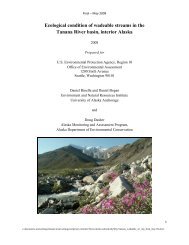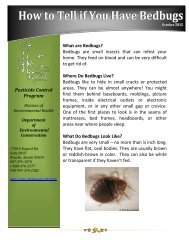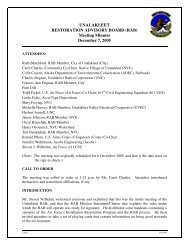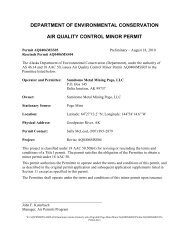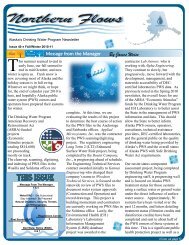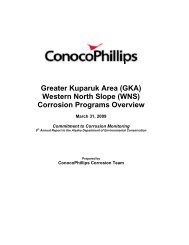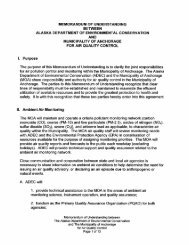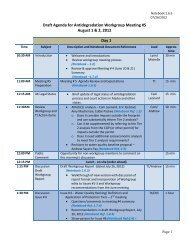2012 Ocean Ranger Guidebook Revision 3-7-12 - Alaska ...
2012 Ocean Ranger Guidebook Revision 3-7-12 - Alaska ...
2012 Ocean Ranger Guidebook Revision 3-7-12 - Alaska ...
Create successful ePaper yourself
Turn your PDF publications into a flip-book with our unique Google optimized e-Paper software.
<strong>20<strong>12</strong></strong> <strong>Ocean</strong> <strong>Ranger</strong> <strong>Guidebook</strong> 3-7-<strong>12</strong><br />
(c) Constant temperature bottles and other containers used for storing or dispensing potable water shall be kept<br />
clean at all times and shall be subjected to effective bactericidal treatment after each occupancy of the space<br />
served and at intervals not exceeding one week.<br />
Sec. <strong>12</strong>50.86 Water for making ice.<br />
Only potable water shall be piped into a freezer for making ice for drinking and culinary purposes.<br />
Job Aid Item: 6.1.b<br />
Text: Potable Water hook ups, in accordance with supplier (municipality or port)/ vessel procedures.<br />
21 CFR <strong>12</strong>40.86; 21 CFR <strong>12</strong>50.82<br />
Background: Any connection to a municipal water system is a<br />
potential source of contamination. Suppliers and vessels have<br />
procedures to minimize this risk.<br />
What to check for: Check that connection procedures are<br />
followed.<br />
Citations: 21 CFR <strong>12</strong>40.86 Protection of pier water system. No<br />
vessel engaged in interstate traffic shall make a connection<br />
between its nonpotable water system and any pier potable water<br />
system unless provisions are made to prevent backflow from the<br />
vessel to the pier.<br />
See item 6.1.a for other applicable citations.<br />
Job Aid Item: 6.1.c<br />
Text: Potable hose is dedicated for potable water and connections are sanitized / capped before use?<br />
(18 AAC 80.015)<br />
Background: Contamination of potable water could occur from hoses or caps used on those hoses. If<br />
connected to a municipal system, this could contaminate that system as well. CDC recommends<br />
connections sanitized with 100 mg/L chlorine and flushing hoses.<br />
What to check for: Check that potable water hoses are dedicated- these could be labeled, properly<br />
stored away from other hoses, etc. Check that connections are sanitized and capped. Check that hoses<br />
are flushed prior to connection and drained after use. Hoses should be stored so that dirt and liquids<br />
cannot collect inside.<br />
Citation:<br />
18 AAC 80.015. Well protection, source water protection, and well decommissioning.<br />
(a) A person may not<br />
(1) cause pollution or contamination to enter a public water system; or<br />
(2) create or maintain a condition that has a significant potential to cause or allow the pollution<br />
or contamination of a public water system.<br />
Job Aid Item: 6.1.d<br />
Text: Potable hose properly stored and used ‘free of the ground’? (18 AAC 80.015)<br />
181






